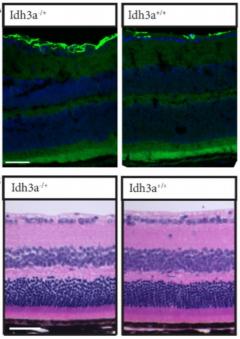New mitochondrial link to retinal degeneration
Mutations in Idh3a lead to defects in mitochondrial dysfunction: Dec 2018

People with mutations in a gene called IDH3A have a disease which causes the light-detecting cells in the eye to die, resulting in blindness. Researchers in Ian Jackson's group at the MRC Human Genetics Unit identified a mouse with a mutation in the same gene which has a similar degenerative disease, but no other symptoms. Disease progression in descendants of this mouse was accompanied with activation of a gene in the retina indicating that the cells were damaged or stressed before they died. The Idh3a gene makes a protein that is involved in the function of mitochondria, the energy-producing system of the cell. Cells from the mutant mice grew normally, but had a reduced maximum energy output.
A mouse strain lacking all Idh3a function did not survive to birth showing that it is an essential gene. However, more subtle gene mutations appear to mostly damage light-detecting retinal cells, which require high energy production by the mitochondria, but not the rest of the cells in the body.
Patients with mutations in another gene, IDH3B, which makes another part of the same protein in mitochondria, also have retinal degeneration, but later in life. However mice lacking IDH3B function appear healthy, including their eyes. This suggests that this part (IDH3B) of the mitochondria protein may not be essential. The lack of eye disease in the mice may be because this is a late-stage disease and the mice do not live long enough to develop it, or that the requirement for IDH3B in the retina is different in mice compared to humans.
Links
Interview with Amy Findlay, lead author: http://dmm.biologists.org/content/11/12/dmm038265
Ian Jackson research group
Original article: doi: 10.1242/dmm.036426


